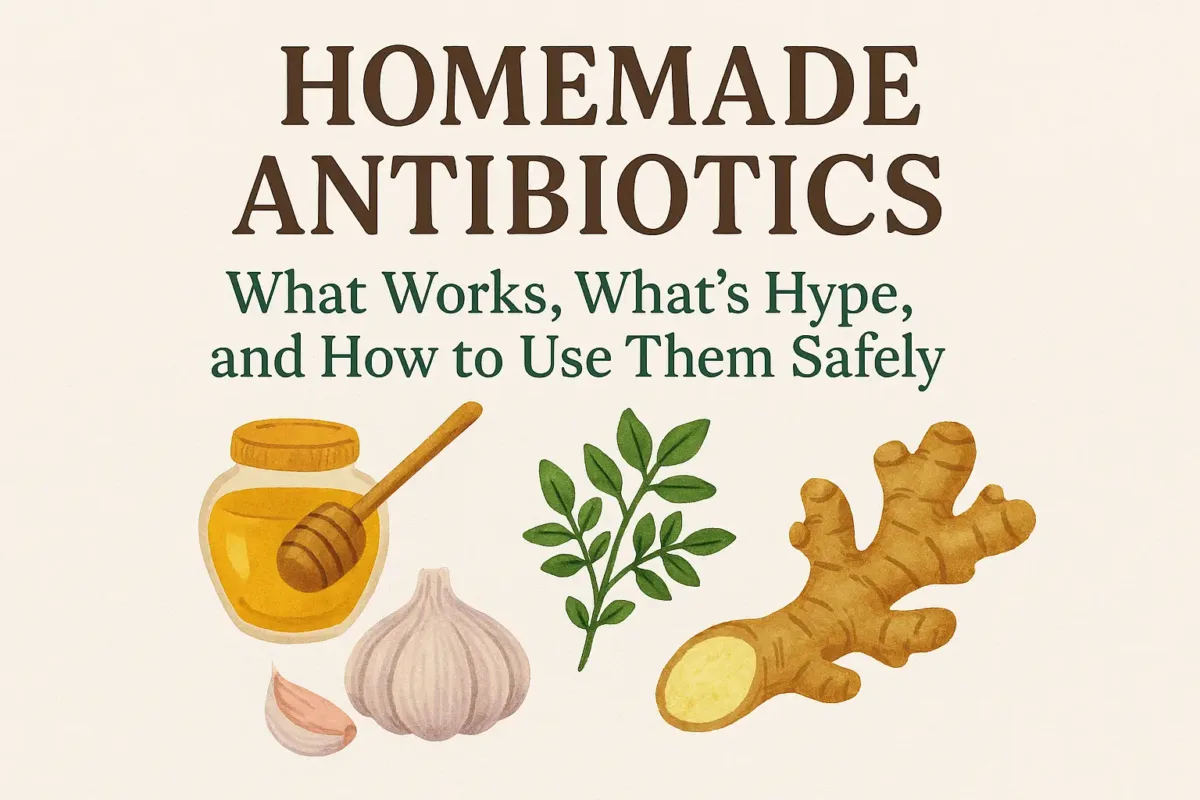Homemade antibiotics are older than pharmacies. For centuries, families reached for garlic, honey, vinegar, and herbs to ease infections, soothe throats, and clean wounds. Today we have life‑saving pharmaceuticals—and yet the wisdom of a well‑stocked kitchen still matters. This guide blends science and tradition so you can tell what truly works, spot the hype, and use natural remedies safely alongside modern medicine.
- How “Homemade Antibiotics” Actually Work
- What Works: The Shortlist of Reliable Home Allies
- What’s Mostly Hype (or Misused)
- 7 Evidence‑Informed “Homemade Antibiotics” Recipes
- 1) Garlic‑Honey Daily Spoon (Immune Support)
- 2) Ginger‑Turmeric Warm Shot (Soothing Inflammation)
- 3) ACV Fire Tonic (Circulation & Airway Support)
- 4) Onion‑Honey Cough Syrup (Family Friendly)
- 5) Thyme Steam (Congestion Relief)
- 6) Clove‑Cinnamon Mouth Rinse (Oral Hygiene)
- 7) Garlic‑Olive Oil for Nails/Skin (Highly Diluted)
- Dose, Dilution, and Safety (The Rules That Keep You Well)
- Building a Week of Antibacterial Eating (Simple, Sustainable)
- Biofilms: Why Some Issues Linger (and What Helps)
- Mind‑Body Medicine: Calm as an Antibacterial Signal
- When to Stop Home Care and Seek Medical Help
- Quality & Sourcing: Getting the Good Stuff
- Common Myths—Gently Retired
- FAQs
- Do homemade antibiotics really work?
- Which homemade remedies are strongest?
- How much raw garlic is safe?
- Can I put honey on a cut?
- Should I ingest essential oils?
- What is fire tonic?
- Are these remedies safe for kids?
- How long can I keep garlic‑honey?
- How do I know when to see a doctor?
- Will these remedies prevent antibiotic resistance?
How “Homemade Antibiotics” Actually Work
Most natural remedies don’t behave like prescription antibiotics that circulate through the bloodstream at high, targeted doses. Instead, kitchen remedies change the terrain—they make tissues less hospitable to microbes while supporting your immune system. Garlic’s allicin interferes with bacterial enzymes; raw honey dehydrates microbes and adds mild hydrogen peroxide; spices like thyme and oregano disrupt cell membranes; vinegar lowers pH so pathogens struggle. These multi‑pathway actions explain why plants helped humanity long before labs—and why resistance develops more slowly.

This also explains their limits: for deep, systemic infections, home remedies are not enough. But for prevention, early symptoms, and surface‑level issues, they can be powerful partners.
What Works: The Shortlist of Reliable Home Allies
- Garlic (raw, freshly crushed): Forms allicin that inhibits common bacteria and some fungi. Best used in small daily amounts in food or as a short, carefully prepared elixir.
- Raw or medical‑grade honey: Antibacterial via osmotic effect, acidity, and enzymes. Medical‑grade varieties (e.g., manuka) are sterilized and standardized for dressings.
- Thyme & Oregano: Rich in thymol and carvacrol; helpful in teas, broths, and culinary use. Essential oils are much stronger and require careful dilution.
- Clove & Cinnamon: Eugenol and cinnamaldehyde show oral and digestive antimicrobial effects; best used as teas or culinary spices.
- Ginger & Turmeric: Antimicrobial and anti‑inflammatory, supporting recovery by calming irritated tissues.
- Apple Cider Vinegar (ACV): Acidic, extracts antimicrobial compounds from herbs, and supports airway/gut hygiene when diluted.
What’s Mostly Hype (or Misused)
- Undiluted essential oils on skin: Can cause chemical burns and allergies.
- Internal use of essential oils: Risky without clinical supervision; potential liver and nervous‑system toxicity.
- Super‑megadoses of raw garlic: More is not better; high doses irritate the gut and skin.
- “Miracle” blends with mostly citrus oils: Lovely scent, minimal antibacterial strength compared to tea tree, thyme, or oregano.
7 Evidence‑Informed “Homemade Antibiotics” Recipes
1) Garlic‑Honey Daily Spoon (Immune Support)
Why it helps: Allicin from garlic + honey’s enzymatic action offer broad antimicrobial support.
- Crush 3–4 garlic cloves, wait 10 minutes for allicin to form.
- Mix with 2 tablespoons raw honey in a small jar; refrigerate.
- Use: 1 small spoon daily during cold season or at first signs.
Note: Strong flavor; reduce to 1 clove if your stomach is sensitive.
2) Ginger‑Turmeric Warm Shot (Soothing Inflammation)
- Blend 1 thumb ginger + 1 thumb turmeric with juice of 1 lemon and ½ cup warm water; strain.
- Stir in 1 tsp honey once the liquid is warm, not hot.
- Use: Sip slowly once daily for 3–5 days.
3) ACV Fire Tonic (Circulation & Airway Support)
- Combine equal parts chopped onion, garlic, ginger, horseradish; add sliced chili.
- Cover with raw apple cider vinegar; infuse 2–4 weeks, shaking daily; strain.
- Use: 1 tablespoon in warm water as needed; store in fridge.
4) Onion‑Honey Cough Syrup (Family Friendly)
- Layer thin onion slices with raw honey in a jar.
- Let sit 6–8 hours until a syrup forms.
- Use: 1 teaspoon every few hours for throat comfort (over age one).
5) Thyme Steam (Congestion Relief)
- Simmer a handful of dried thyme in water; pour into a bowl.
- Tent towel and inhale steam for 5–7 minutes with eyes closed.
- Optional: Add 1 drop tea tree to the hot water (not more).
6) Clove‑Cinnamon Mouth Rinse (Oral Hygiene)
- Steep 2 cloves and ½ stick cinnamon in a cup of hot water; cool.
- Swish briefly; do not swallow if you have sensitive stomach.
- Use: Once daily for 3–5 days during flare‑ups.
7) Garlic‑Olive Oil for Nails/Skin (Highly Diluted)
- Mix 1 very small crushed clove into 2 tablespoons olive oil; let sit 1 hour; strain.
- Apply sparingly to intact skin around nails 2–3x weekly; patch‑test first.
Dose, Dilution, and Safety (The Rules That Keep You Well)
- Raw garlic: 1–2 small cloves daily in food for most adults.
- Honey: Avoid in infants under one; diabetics should use sparingly with meals.
- Essential oils: 0.25–1% for face; 1–2% body; avoid internal use unless supervised.
- Vinegar tonics: Always dilute (1 tablespoon in a cup of warm water).
- Open wounds: Use only sterilized, medical‑grade honey dressings; pantry honey is for intact skin and drinks.
- Allergies & meds: Garlic can interact with blood thinners; clove/cinnamon may irritate tissues—adjust or avoid.
Building a Week of Antibacterial Eating (Simple, Sustainable)
Consistency beats intensity. Here’s a rhythm that keeps benefits steady without stressing digestion:
- Morning: Warm lemon water with a touch of raw honey; ginger‑turmeric tea later.
- Lunch: Big salad with raw‑garlic vinaigrette (olive oil, lemon, crushed clove rested 10 minutes).
- Afternoon: Cinnamon‑clove tea or yogurt with a drizzle of honey.
- Dinner: Broth or stir‑fry finished with fresh thyme/oregano and a clove of garlic added at the end.
- Weekly prep: Make small jars of garlic‑honey and ACV fire tonic; brew a pot of ginger‑turmeric tea.
Biofilms: Why Some Issues Linger (and What Helps)
Bacteria often hide in biofilms—slimy shields that reduce the effectiveness of cleansers and some drugs. Phenol‑rich herbs (oregano, thyme, clove) and consistent hygiene can help gently disrupt these layers. That’s one reason short, regular exposure through foods and rinses may feel surprisingly effective over time.
Mind‑Body Medicine: Calm as an Antibacterial Signal
Stress chemistry suppresses immune surveillance. Warm teas, aromatic cooking, and steady meals do more than nourish—they whisper “you’re safe” to the nervous system. Sleep, hydration, and gentle movement then complete the loop. The body heals best when it is not afraid.
When to Stop Home Care and Seek Medical Help
- Fever above 38.5 °C / 101.3 °F or symptoms that worsen after 48–72 hours
- Spreading redness, pus, severe pain, chest tightness, or shortness of breath
- Deep puncture wounds, diabetic foot injuries, or signs of sepsis (confusion, fast heart rate)
Natural remedies are supportive. Timely medical diagnosis saves lives.
Quality & Sourcing: Getting the Good Stuff
- Garlic: Buy whole, firm bulbs; avoid pre‑minced jars for medicinal use.
- Honey: Choose raw for drinks; medical‑grade manuka for dressings. Look for UMF/MGO ratings.
- Spices: Whole cloves/cinnamon sticks retain volatile oils better than pre‑ground.
- Herbs: Organic, recently dried, or fresh whenever possible.
- Vinegar: Raw ACV with the “mother” for infusions.
Common Myths—Gently Retired
- “Natural equals harmless.” Powerful plants demand respect; dosage and dilution matter.
- “If a little helps, a lot cures.” Overdoing spices, garlic, or oils can inflame tissues and slow healing.
- “Herbs replace antibiotics.” They complement prevention and early care; severe infections need clinical treatment.
FAQs
Do homemade antibiotics really work?
Many kitchen remedies show antimicrobial effects in research and practice, especially for surface‑level issues and early symptoms. They support—not replace—medical care.
Which homemade remedies are strongest?
Raw garlic, raw/medical‑grade honey, oregano/thyme, and clove/cinnamon are among the most researched.
How much raw garlic is safe?
Most adults tolerate 1–2 small cloves daily in food. Higher amounts may irritate digestion.
Can I put honey on a cut?
Use sterilized, medical‑grade honey for open wounds. Pantry honey is best for drinks and intact skin.
Should I ingest essential oils?
Not without clinical supervision. Concentrated oils can damage organs and interact with medications.
What is fire tonic?
An ACV infusion of garlic, onion, horseradish, ginger, and chili. It’s stimulating and antimicrobial; always dilute before sipping.
Are these remedies safe for kids?
Use gentle, food‑level doses; avoid honey under age one and strong essential oils on children.
How long can I keep garlic‑honey?
Refrigerate and use within 1–2 weeks; discard if mold or fizzing appears.
How do I know when to see a doctor?
High fever, spreading redness, severe pain, breathing issues, or symptoms lasting beyond a few days—seek care promptly.
Will these remedies prevent antibiotic resistance?
Using herbs for mild issues may reduce unnecessary antibiotic use, which supports stewardship—but they do not treat serious infections.
Homemade remedies aren’t a rebellion against medicine; they’re a reunion with it—food and plants doing what they’ve always done: help the body remember how to heal.
If this spoke to you, you’ll love the full information in this book; begin your deeper reading → See the book on Mayobook.


